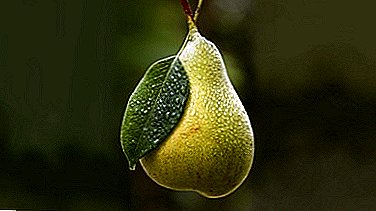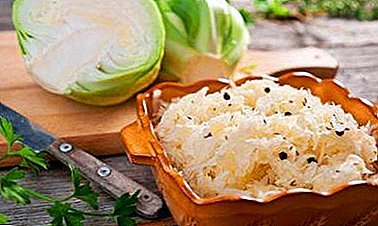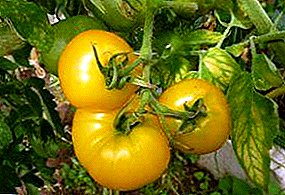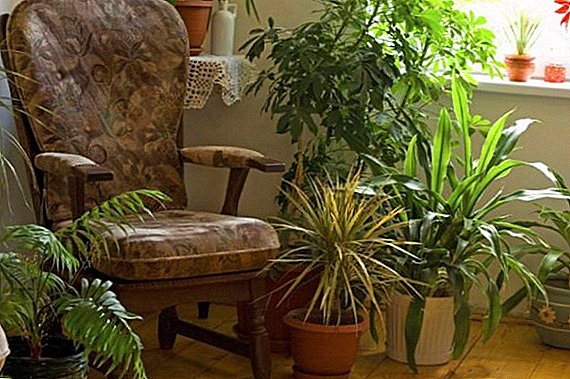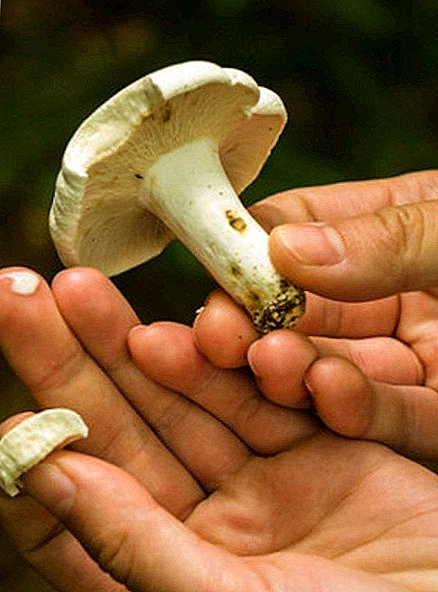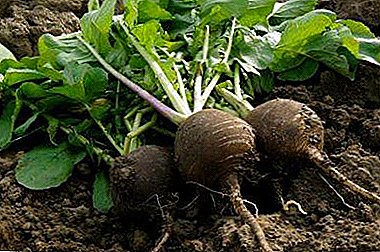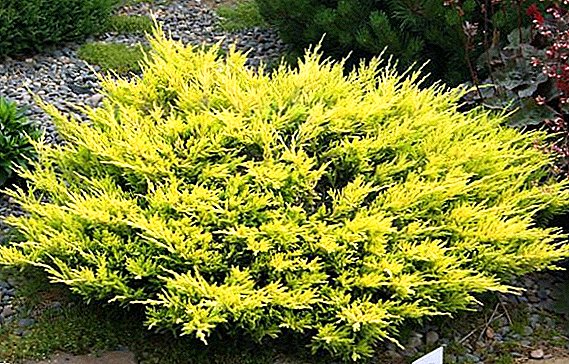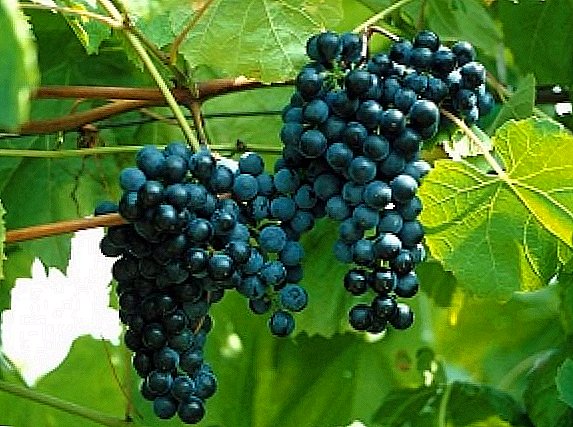
Unlike table varieties, technical varieties have a high content of juice in the berries.
For manufacturers of products, the physico-chemical properties of the grapes are paramount, while the appearance of the berries themselves is secondary.
Technical varieties are less whimsical to the conditions of care and are grown, as a rule, in a more mechanized way in large areas. Fans of homemade wine also prefer to have on the plot of land several bushes of such grapes.
Consider the most favorite varieties of growers.
About the variety "Muscat white"

More than once, this name was met by us on a bottle of wine, which indicates the fact that this variety suitable for making dessert and table winesas well as juices. The berries of this variety have a characteristic nutmeg rich flavor and juicy flesh with a small amount of seeds.
The leaves are distinguished by wide serrations and light streaks, the edge of the leaf is also highlighted.
Productivity fluctuates within 60-100 c / ha. Clusters have a cylindrical shape and an average size. The mass of each can be from 100 to 450 g, and the length varies from 13 to 17 cm.
The term of ripening is 140 days (from the beginning of the growing season to harvest). Muscat is a medium late variety.
The advantages of this variety are high sugar content in the berries and its distinctive exquisite aroma, which favorably distinguishes nutmeg varieties from other varieties, and allows it to act as an excellent raw material for the manufacture of a variety of wines. In addition, it can be eaten fresh and as table grapes.
The disadvantages of the variety include its low resistance to various diseases, poor frost resistance and susceptibility to pea.
A place to plant this grape should be chosen with special care, given its features. This should be a plot protected from cold winds, with sufficiently moist soil and good snow accumulation.
Landing time in the autumn - from the end of September to the beginning of October. We remind you that during this period only saplings well prepared for winter are used. With a developed root system and matured vine.
In spring, planting takes place after the soil warms up (up to 12º C) and air (up to 18º C), most often at the end of April, but everything depends on the region.
For maximum yields, it is recommended to resort to additional pollination (preferably with pollen from planting varieties). Fight the thickening of bushes by breaking off unwanted young shoots, as well as controlling the growth of grafted bushes, not allowing them to go to their roots, which can happen if you do not produce katarovka on time.
Aligote - another grape of the same name of wine

Unlike muscadine grapes, this variety has no specific taste and has a fairly simple taste that does not reduce its value in the eyes of winemakers, and allows it to continue to occupy a leading position in this industry.
The characteristic distinguishing features of this variety are the dark green color of the leaf, the edges of which are slightly bent down, and the wine-red color of the shoots and stalks. The yield is 90-140 kg / ha. The bunch can reach 15 cm in length and 10 cm in width. The average weight is 105 grams. The berries have a yellow-green color and brown blotches.
Maturity early middle - 130 days. Harvesting takes place at the end of August - beginning of September.
TO benefits The physicochemical properties of grapes can be attributed, although it is much more sour than white Muscat, as well as a high proportion of juice content in berries (78%).
Disadvantages are: susceptibility of gray rot and mildew, average frost resistance, although it is higher compared to the previous variety, as well as low transportable qualities.
The ideal place to accommodate this grape variety is near the forest belts, where the snow is covered and there is a longer saturation with moisture. This will somewhat delay the release of the kidneys. Will fit light soils with good water permeability. In the foothill areas recommended soil mixed with stony debris.
Planting dates are the same as other grape varieties. In the autumn - before the onset of the first frosts, and in the spring - until the beginning of the growing season, when the temperature of the soil and air warms up sufficiently.
Care is basically the same as for other varieties, with the exception of some features: in spring, debris must be produced earlier than usual, because dormant buds of this variety wake up earlier, and abundant growth will negatively affect the strength of the bush . The best timeframe for this process falls on May 8-10.
It is also interesting to read about the best grapes for the Moscow region
Grade of grapes "Isabella"

There is hardly a person who has not heard of this grape variety. Despite the fact that in industry this sort of steel has been used much less often, but it is deservedly that you can assign the title of "veteran", and it still remains a favorite among domestic winemakers.
Bunches of grapes have a cylindrical shape, often not quite dense, sometimes with sparse sites. The berries are dark blue with a pronounced wax coating, the skin is rather dense, the flesh has a strawberry flavor.
The yield of about 70 kg / ha. The average bunch weight ranges from 130 to 150 grams.
The term of ripening is medium and varies between 150-180 days. Bushes are vigorous and need support in the form of stretched wire or other fastening elements.
This variety has enough "pluses", otherwise it would not occupy a leading position among technical varieties for such a long time.
The main advantages are the unpretentiousness of the variety to the soil, its high frost resistance (variety can not cover for the winter), good resistance to various diseases. For the human body, it is simply a storehouse of beneficial substances that have a beneficial effect on the functioning of various organs and systems.
But the "cons" are also available. For example, in some countries, this grape is for some time forbidden, as a raw material for making wines, because of the high methanol content. A lot of controversy goes to this point, and many consider this to be fiction of individual companies to eliminate competition.
Anyway, we continue to grow this variety and enjoy the products we get from it.
Isabel sensitive to excess limestonetherefore, it will be better to feel yourself on soils with its low content. Excess moisture tolerates better than drought. The lack of water will lead to the fall of the leaves and lower yields. But this does not mean that the grapes will be comfortable in the lowlands.
In addition, it is not recommended to plant it near fences where ventilation will be limited.
Planting dates do not differ from other varieties.
Regular loosening of the soil and protection from weeds, the application of mineral fertilizers three times per season, and organic - 1 time every two years - the main stages of care for this variety. Recommended for winter soil mulching with peat or sawdust. Do not neglect the procedure for pruning grapes, as it is prone to thickening, which will subsequently reduce its yield.
Beautiful and common technical grape variety - "Chardonnay"

The variety has leaves of medium size, with characteristic convex wrinkles. The berries are greenish-white, small in size (up to 16 mm in diameter) and with a thin skin. The flesh is juicy and tasty.
Yield characterized as average (50-70 c / ha). The cluster, as a rule, does not exceed a mass of 90 g, reaches a length of about 13 cm, and 10 cm wide. The maturation period from the beginning of bud break to the first harvest is 138-140 days.
Dignity - taste.
Disadvantages: the variety is affected by oidium and mildew, with large amounts of precipitation prone to decay, insufficiently frost-resistant, earlier development of the kidneys, which is fraught with their freezing.
Loves stony and clay-calcareous soils. When planting it is better to give preference to elevated sites or western slopes.
Landing is carried out in early spring (after the end of frost) or in mid-autumn (before the onset of the first frost).
Need to avoid thickening of the crown and overload shoots. In the process of pruning is recommended to leave 10-12 eyes. The bush should have 4 fruit links. When grown under conditions of unopened viticulture, shafts up to 120 cm high are formed.
Grape variety "Cabernet Sauvignon"

Another of the sensational names, quite often appearing on the rumor. Thanks to this variety, a lot of various red wines have appeared, and this variety is still one of the favorite winemakers.
The variety is distinguished by saturated dark green five-lobed leaves with strong cuts and large triangular teeth. The berries are dark blue, rounded and waxed. The skin is rough and thick, the taste of the pulp is compared with currant, and it gives the wine a special tartness.
Productivity 60-90 c / ha. The average bunch weight is 70 g, length - 12-15 cm, width up to 8 cm.
The term of ripening for the preparation of table wines is 140 days, and for the preparation of dessert wines - 165 days.
Among the "advantages" increased resistance to mildew and gray rot, as well as distinctive taste.
"Minuses" may be a tendency to fall off the ovary and the grinding of berries. Resistance to weather characterized as average.
It is believed that this variety is better planted in a temperate or warm climate. From this will depend on the taste of the wine and saturating it with toughness. Best of all this variety will feel on the slopes, although it is not particularly fastidious about the soil and growing conditions.
The planting dates are no different from other grape varieties and fall on the beginning of spring and mid-autumn.
If you carry out a short pruning of annual shoots, the fruitfulness of the lower eyes will increase significantly. When harvesting grapes for vintage wines, it is recommended to reduce the length of the fruit arrows and the load on the bush.
The best are high-shtambovye formations, with a few hanging young growth. In this case, it is necessary to observe the distance and width between the rows (3-4m), and it is advisable to cut annual shoots by 5-6 holes.


